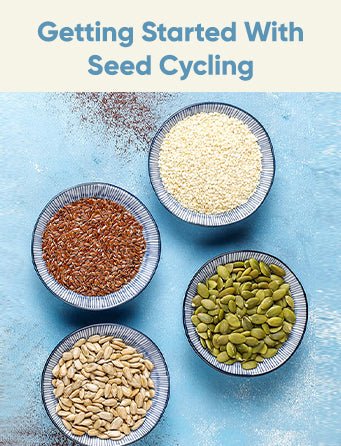
Getting Started With Seed Cycling
Share
In a perfectly healthy body, the hormone levels stay naturally balanced throughout the menstrual cycle. However, this delicate balance is easily disrupted by stress, food additives, toxins in the environment, digestive issues and excessive coffee consumption.

Hormonal Issues Faced By Women
Lately, an increasing number of women have been struggling with hormonal imbalances and all the issues that come with it. Hormonal imbalance may be caused by PCOS, irregular periods, hypothyroidism, and weight issues. Missing your period causes you to lose your hair, gain weight, cause acne, grow facial hair, affect sleep, impact libido and your overall energy levels. Some women even have fertility issues that makes it difficult for them to get pregnant. Doctors usually prescribe a long list of medicines that have many side effects and can be very hectic to keep up with. A newly trending but an ancient remedy is a simple way to deal with all these issues, without the side effects from traditional medicines, is seed cycling.
What Is Seed Cycling?
Seed cycling is the process of consuming certain seeds at particular times in your cycle to help regulate your hormones. Rotating flax, pumpkin, sesame, and sunflower seeds help with the regulation of estrogen and progesterone. These different seeds offer distinctive nutritional benefits that support healthy hormone production in the two phases of your cycle. Each phase typically lasts about 14 days.
- Phase 1-The follicular phase (day 1-14)
Take one tablespoon of freshly ground flax and pumpkin seeds everyday.
- Phase 2-The luteal phase (day 15-28)
Take one tablespoon of freshly ground sesame and sunflower seeds everyday
Day 1 of the phase is the day you begin to menstruate and the phase lasts till ovulation. Then, the next phase begins and lasts till your next period.
Note: It is completely normal for both the phases to last from anywhere between 12-17 days. You can just adjust your consumption according to the length of your cycle.
How Can Seed Cycling Help?
Whether you are a teen, middle aged or menopausal woman, seed cycling is something that can help you at any stage in life.
The scientific evidence confirming whether or not seed cycling works can be found at the basic level, when you look at the nutritional properties of individual seeds and how they may benefit you.
Flaxseeds are known to contain phytoestrogens, which are plant-based compounds that have an anti-estrogen effect and weak estrogen properties. These may aid in lengthening the second phase and possibly result in better ovulation.
Flaxseeds are rich in lignans, another plant-based compound that reduces estrogen activity, along with binding up excess estrogen. The binding effect actually stops excess production of this hormone when progesterone is rising in the second phase of the cycle. Flaxseeds are also a source of omega-3 fatty acids that are vital for follicle function and hormone production. It is also said to improve blood circulation in the uterus and possibly increase progesterone levels as seen in animal studies.
Pumpkin seeds are also a source of lignans and contain high zinc content, which makes up about 15% of the daily recommended dietary allowance. Zinc maybe associated with less intense menstrual cramps as it works to decrease the metabolism and prostaglandins, that are said to cause cramps. They are also a source of omega-3 fatty acids.
Sunflower seeds are a good source of omega-3 fatty acids and vitamin E, which a study suggests is helpful in improving progesterone levels in the body. This hormone helps in keeping the pregnancy in its early stages for women who take a while to conceive.
Women in their post-menopausal phase have been observed to have increased levels of vitamin E circulating in their bodies after consuming sesame seeds. These seeds contain phytoestrogens and are also a source of lignans and omega-3 fatty acids.
Seed cycling can be a good support for your cycle and overall reproductive health. This is an easy method with potentially high rewards and minimal risks, that has worked for many women out there and it just might work for you too.
